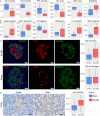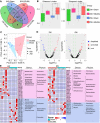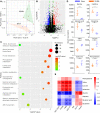The role of gut microbiota and amino metabolism in the effects of improvement of islet β-cell function after modified jejunoileal bypass
- PMID: 33637880
- PMCID: PMC7910448
- DOI: 10.1038/s41598-021-84355-x
The role of gut microbiota and amino metabolism in the effects of improvement of islet β-cell function after modified jejunoileal bypass
Abstract
The change in gut microbiota is an important mechanism of the amelioration of type 2 diabetes mellitus (T2DM) after bariatric surgery. Here, we observe that the modified jejunoileal bypass effectively decreases body weight gain, fasting blood glucose, and lipids level in serum; additionally, islet β-cell function, glucose tolerance, and insulin resistance were markedly ameliorated. The hypoglycemic effect and the improvement in islet β-cell function depend on the changes in gut microbiota structure. modified jejunoileal bypass increases the abundance of gut Escherichia coli and Ruminococcus gnavus and the levels of serum glycine, histidine, and glutamine in T2DM rats; and decreases the abundance of Prevotella copri and the levels of serum branched chain amino acids, which are significantly related to the improvement of islet β-cell function in T2DM rats. Our results suggest that amino acid metabolism may contribute to the islet β-cell function in T2DM rats after modified jejunoileal bypass and that improving gut microbiota composition is a potential therapeutic strategy for T2DM.
Conflict of interest statement
The authors declare no competing interests.
Figures






Similar articles
-
A specific gut microbiota and metabolomic profiles shifts related to antidiabetic action: The similar and complementary antidiabetic properties of type 3 resistant starch from Canna edulis and metformin.Pharmacol Res. 2020 Sep;159:104985. doi: 10.1016/j.phrs.2020.104985. Epub 2020 Jun 3. Pharmacol Res. 2020. PMID: 32504839
-
An Integrated Fecal Microbiome and Metabolomics in T2DM Rats Reveal Antidiabetes Effects from Host-Microbial Metabolic Axis of EtOAc Extract from Sophora flavescens.Oxid Med Cell Longev. 2020 May 27;2020:1805418. doi: 10.1155/2020/1805418. eCollection 2020. Oxid Med Cell Longev. 2020. PMID: 32566075 Free PMC article.
-
Diabetes and branched-chain amino acids: What is the link?J Diabetes. 2018 May;10(5):350-352. doi: 10.1111/1753-0407.12645. Epub 2018 Feb 13. J Diabetes. 2018. PMID: 29369529
-
Effect of traditional Chinese medicine on gut microbiota in adults with type 2 diabetes: A systematic review and meta-analysis.Phytomedicine. 2021 Jul 15;88:153455. doi: 10.1016/j.phymed.2020.153455. Epub 2020 Dec 30. Phytomedicine. 2021. PMID: 33478831
-
Gut Microbiota and Gestational Diabetes Mellitus: A Review of Host-Gut Microbiota Interactions and Their Therapeutic Potential.Front Cell Infect Microbiol. 2020 May 15;10:188. doi: 10.3389/fcimb.2020.00188. eCollection 2020. Front Cell Infect Microbiol. 2020. PMID: 32500037 Free PMC article. Review.
Cited by
-
Role of Branched-Chain Amino Acid Metabolism in Type 2 Diabetes, Obesity, Cardiovascular Disease and Non-Alcoholic Fatty Liver Disease.Int J Mol Sci. 2022 Apr 13;23(8):4325. doi: 10.3390/ijms23084325. Int J Mol Sci. 2022. PMID: 35457142 Free PMC article. Review.
-
Gut Microbiota and Mycobiota Evolution Is Linked to Memory Improvement after Bariatric Surgery in Obese Patients: A Pilot Study.Nutrients. 2021 Nov 13;13(11):4061. doi: 10.3390/nu13114061. Nutrients. 2021. PMID: 34836316 Free PMC article.
-
A two-sample bidirectional Mendelian randomization analysis investigates associations between gut microbiota and type 2 diabetes mellitus.Front Endocrinol (Lausanne). 2024 Mar 1;15:1313651. doi: 10.3389/fendo.2024.1313651. eCollection 2024. Front Endocrinol (Lausanne). 2024. PMID: 38495787 Free PMC article.
-
Metabolomic Workflow for the Accurate and High-Throughput Exploration of the Pathways of Tryptophan, Tyrosine, Phenylalanine, and Branched-Chain Amino Acids in Human Biofluids.J Proteome Res. 2022 May 6;21(5):1262-1275. doi: 10.1021/acs.jproteome.1c00946. Epub 2022 Apr 5. J Proteome Res. 2022. PMID: 35380444 Free PMC article.
-
Essential Amino Acid Metabolites as Chemical Mediators of Host-Microbe Interaction in the Gut.Annu Rev Microbiol. 2023 Sep 15;77:479-497. doi: 10.1146/annurev-micro-032421-111819. Epub 2023 Jun 20. Annu Rev Microbiol. 2023. PMID: 37339735 Free PMC article. Review.
References
Publication types
MeSH terms
Substances
LinkOut - more resources
Full Text Sources
Other Literature Sources

